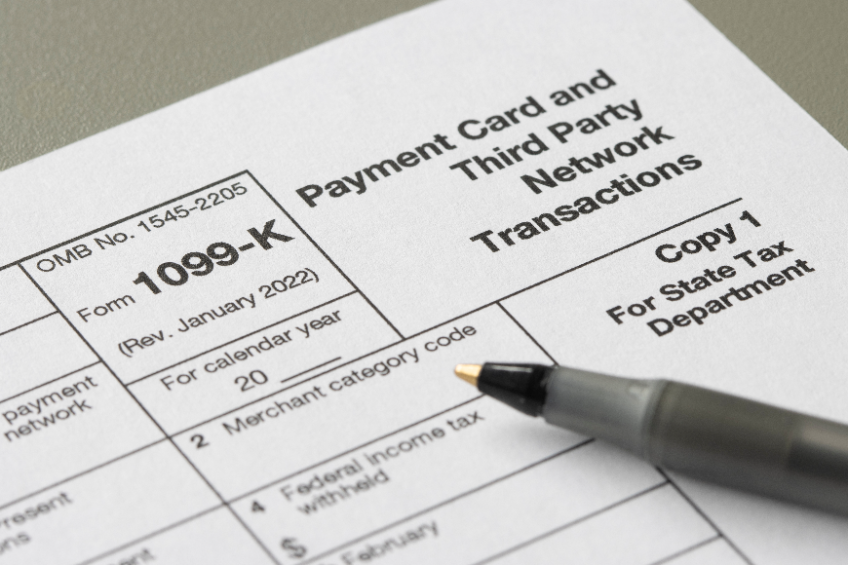
Purpose of the 1099-K Form
The 1099-K form is a tax form used by the Internal Revenue Service (IRS) to track and report payment transactions made through third-party networks. Third-party networks include companies like PayPal, Square, Etsy, Uber, and other payment processors.
The 1099-K form shows the total amount of payment transactions made by a taxpayer through these third-party payment networks. Specifically, the form reports the gross amount of payment card transactions made through the network, including debit, credit, and stored-value payment cards, as well as the number of transactions made.
The purpose of the 1099-K form is to ensure that taxpayers are reporting all income received from payment transactions made through third-party networks. Payment processors who meet certain thresholds are required to file 1099-K forms with the IRS and provide a copy to the taxpayer. This reporting requirement is designed to prevent taxpayers from underreporting income and helps the IRS to identify potential tax fraud.
The IRS requires payment processors to file 1099-K forms if they have at least 200 transactions and $20,000 in gross payments processed during the year. The threshold is lower in some states, such as Massachusetts, Vermont, and Virginia, where payment processors are required to file if they have at least 100 transactions and $600 in gross payments processed during the year.
Overall, the 1099-K form is an important informational document that helps the IRS to ensure taxpayers are reporting all income received from third-party payment networks. Taxpayers should use the information on the 1099-K form to accurately report their taxable income on their income tax return.
Who is Required to File a 1099-K?
If you operate a business in the United States and receive payment transactions using a payment card or app, chances are that you may be required to file a 1099-K form with the IRS. This tax form is mandatory for businesses whose payment volume meets or exceeds the minimum reporting threshold set by the IRS.
The types of businesses that are required to file a 1099-K include sole proprietors, corporations, and partnerships. If your business falls under one of these categories and you meet the minimum threshold for payment received, it’s important to file your 1099-K form on time to avoid IRS penalties.
By filing a 1099-K, you’ll benefit from better organization of payment transactions, which can simplify your accounting processes. When you accurately report your taxable income, the IRS can ensure that you are paying the correct amount of taxes owed. The benefits of filing a 1099-K are numerous, as it can help you avoid tax audit, penalties, and other legal issues that arise from noncompliance.
Payment Transactions and Reporting Thresholds
Payment transactions are defined as exchanges of money for goods or services using payment methods such as credit cards, debit cards, or other electronic payment methods. Reporting thresholds refer to the minimum volume of payment transactions that require reporting to the IRS through a 1099-K form. This form is required to be reported if your total payment volume exceeds $20,000 or if you have more than 200 payment transactions throughout the year.
What are Payment Transactions?
Payment transactions are the lifeblood of any business. They refer to the process of exchanging money for goods or services through various payment methods, such as credit or debit cards, payment networks, or other third-party processors. Payment transactions can take place in-person, online, or through mobile devices, and can involve a variety of payment methods.
When a business receives payment for goods or services through these methods, they are considered payment transactions. These transactions are subject to reporting requirements on Form 1099-K. This form helps the IRS track payment transactions and identify potential cases of tax evasion. It’s important to ensure that all payment transactions are accurately recorded and reported to avoid common errors and comply with IRS regulations.
If you exceed certain thresholds, you may be required to report your payment transactions on a 1099-K form. The reporting requirements for payment transactions are generally triggered if your total payment volume exceeds $20,000 or if you have more than 200 payment transactions throughout the year. If you meet these thresholds, you are required to report your payment transactions on Form 1099-K. Failure to do so can result in penalties and fines.
Payment transactions are an essential part of any business, and it’s important to track and accurately report them. Payment transactions can be processed using credit or debit cards, payment networks, or other third-party processors. It’s important to understand the reporting requirements for payment transactions, especially if you use credit or debit cards, payment networks, or other third-party processors.
What are Reporting Thresholds?
When it comes to Form 1099-K, businesses and individuals are required to report payment transactions that meet certain reporting thresholds. These thresholds outline the limits in gross payments and the number of transactions that trigger reporting requirements for payment settlement entities and third-party network transactions. Staying up to date with these thresholds is essential in accurately reporting payment transactions and avoiding penalties.
For the 2022 tax year, payment settlement entities and third-party network transactions are required to report payment transactions if the gross payments meet or exceed $20,000 and the total number of transactions is 200 or more. However, starting from the 2023 tax year, the reporting threshold for payment settlement entities and third-party network transactions will lower to $600, and the requirement to report transactions will be removed.
This anticipated change for 2023 tax year can have a significant impact on businesses, especially small businesses. With the lower reporting threshold, businesses will have to report all payment transactions that meet or exceed $600. This will require businesses to distinguish between personal and professional expenses to accurately report their taxable income. As a result, businesses may have to adopt new tracking systems to differentiate personal and business expenses.
When is a 1099-K Required to be Reported?
The 1099-K form is required to be reported by payment settlement entities if the combined amount of reportable payment transactions for the year exceeds $20,000 and the total number of transactions exceeds 200. It is important to remember that the form only applies to business transactions and not personal payments. Additionally, businesses should make sure that their contact information is up to date to ensure that they receive the 1099-K form by the January 31 deadline.
It is important to note that Form 1099-K only applies to reportable payment transactions conducted through businesses and not personal payments. This means that payments made for personal items or expenses are not required to be reported on the form.
Third-Party Payment Network Transactions and the 1099-K
Third-Party Payment Networks are online platforms that allow businesses and individuals to process payment transactions without the need for a direct relationship with their customers. PayPal, Venmo, and Square are some examples of networks serve as intermediaries between buyers and sellers, providing a secure and seamless way to facilitate transactions. These networks are required to report payment transactions using Form 1099-K if certain criteria are met.
The 1099-K form specifically covers payment transactions made through payment settlement entities, including third-party payment networks and credit card companies, where the combined amount of reportable payment transactions for the year exceeds $20,000 and the total number of transactions exceeds 200. To report payments received through a third-party payment network on tax forms, businesses must ensure that they have accurate records of payments issued through these networks and report the appropriate amounts on their income tax return.
There are various types of payment transactions that can be processed through third-party payment networks, including credit card transactions, debit card transactions, and electronic fund transfers. By utilizing these networks, businesses and individuals can streamline their payment processing and reduce the need for physical cash or check transactions.
For businesses, third-party payment networks offer a range of benefits, such as simplified payment processing, reduced transaction costs, and increased efficiency. These networks can be particularly advantageous for small businesses and sole proprietors who do not have access to traditional payment processing methods.
Individuals can also benefit from using third-party payment networks to process payments. Whether it’s splitting expenses with friends or making online purchases, these networks offer a convenient and secure way to transfer money.
How Do I Report Payments Received Through a Third-Party Payment Network on my Tax Forms?
If you have received payments through a third-party payment network and the transactions meet the reporting threshold, you will receive a Form 1099-K from the payment settlement entity. This form will report the total gross amount of all reportable payment transactions. But how do you report the income on your tax return?
To accurately report the income received through a third-party payment network, you must report the gross amount on Schedule C or Schedule F, depending on the type of business entity you are classified as. It is important to include the cost of goods sold and associated business expenses when calculating the final taxable income.
Just like payment card transactions, the reporting thresholds for third-party payment networks can vary based on state requirements. It is important to check the current threshold by visiting the IRS Form 1099-K Payment Card and Third-Party Network Transactions site.
Sole Proprietors and Business Income
A sole proprietorship is a type of business entity that is owned and operated by a single individual. It is the simplest and most common form of business since it requires no formal organizational structure or legal documentation.
From a tax perspective, being a sole proprietor means that the owner reports the business income and expenses on their personal tax return. This is because the business is not viewed as a separate entity for tax purposes. As a result, any profit or loss from the business is reported on the owner’s personal tax return.
To accurately report business income and expenses, sole proprietors must file a Schedule C, Profit or Loss from Business, with their income tax return. The Schedule C lists the business’s income, expenses, and net profit or loss. In addition to paying income taxes, sole proprietors must also pay self-employment taxes on their net business income. For tax purposes, the owner is viewed as both the employer and the employee, which means they must pay Social Security and Medicare taxes on their net income. These self-employment taxes are in addition to any income taxes owed.
What 1099-K changes might come when you file in 2024?
When it comes to filing taxes, it’s important to accurately report all taxable income and expenses. For business owners who use personal credit cards or payment methods for business purchases, it can be difficult to distinguish between personal and business transactions. However, it’s crucial to correctly categorize these transactions to avoid any potential problems with the IRS. In addition, it’s important to note that personal items or payments should never be included in business expense deductions. In preparation for the 2023 tax return, it’s vital to keep these things in mind and properly remove any personal transactions or items from business expenses.
Personal Transactions, Credit Card Companies, and Personal Items/Payments
Personal transactions, credit card companies, and personal items/payments can all have an impact on tax reporting. In particular, personal transactions made using payment cards or third-party payment processors may be included in business payments received and reported to the IRS through Form 1099-K. This can cause issues if personal transactions are mistakenly included in business payments, leading to discrepancies and possible penalties.
To avoid any confusion, it is important to keep accurate records of personal transactions and ensure that they are not mistakenly included in business payments. Additionally, credit card companies may also report personal transactions to the IRS, which could create further discrepancies with tax filings. To ensure proper tax reporting, it’s important to verify that all transactions included in Form 1099-K are related to business income and exclude any personal transactions.
Personal items or payments that are not considered taxable income, such as personal gifts or loans, should be excluded from tax reporting altogether. These items or transactions are not considered part of a business’s taxable income and should not be included in Form 1099-K.
By keeping accurate records of personal transactions and excluding any personal items/payments that are not considered taxable income, small business owners can ensure that their tax reporting is accurate and avoid any potential problems with the IRS. Remember to keep the keywords “personal transactions”, “credit card companies”, “third-party payment processors”, “taxable income”, and “Form 1099-K” in mind while preparing tax returns.

Markos Banos
Markos M. Baños Cabán, Esq., is the Director of Resolutions at Community Tax LLC, where he leads a team of practitioners and service professionals dedicated to resolving complex tax conflicts, including IRS audits, tax liens, and tax debt. A licensed attorney, tax practitioner, and notary public in Puerto Rico, Markos combines his extensive legal expertise and management skills to deliver exceptional results and reduce stress for his clients. He holds a Juris Doctor from the University of Puerto Rico School of Law and has experience in a variety of legal fields, as well as industrial management. Bilingual in English and Spanish, Markos is also a published researcher with a passion for delivering outstanding service.







